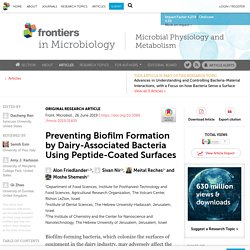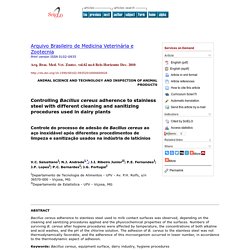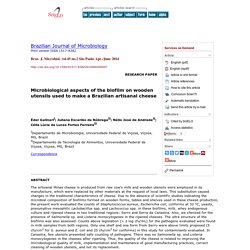

FRONT. MICROBIOL. 26/06/19 Preventing Biofilm Formation by Dairy-Associated Bacteria Using Peptide-Coated Surfaces. Introduction Biofilm-forming bacteria are known to be a major source of both spoilage and pathogenic microflora in the dairy industry (Elmoslemany et al., 2009).

Therefore, bacteria that form biofilms may adversely affect the safety and quality of milk and its products (Moretro and Langsrud, 2017). The main source of contamination of dairy products is often associated with the formation of biofilms on the surfaces of milk transport pipes, milking containers, and accessories in the dairy industries (Srey et al., 2013). Biofilms are established mainly under conditions that allow bacteria to easily adhere to the walls of the pipes, for example, when the milk is found in transport pipes without flow (Stoodley et al., 2002). The bacteria may detach from biofilms and contaminate the milk as it passes surfaces (Austin and Bergeron, 1995). One of the possible strategies to combat biofilm formation is by preventing bacterial adhesion to surfaces in advance (Palmer et al., 2007).
Materials Results. UNIVERSIDADE DE SAO PAULO - 2015 - Thèse en ligne : Staphylococcus aureus and Listeria monocytogenes isolate from dairy plants: occurrence, evaluation of biofilm formation ability and inactivation by peracetic acid and cold plasma. Renc. Rech. Ruminants, 2003, 10 Virulence de Listeria monocytogenes en biofilm : conséquences en élevage laitier.
ONTARIO - 2006 - Titre: Maintien de la qualité du lait par la maîtrise des biofilms dans les lactoducs. Un biofilm est constitué de cellules bactériennes qui peuvent élever la numération sur plaque et abaisser la qualité du lait qui circule dans le lactoduc.

Les biofilms sont partout. Ils sont responsables de la plaque dentaire autant que de la viscosité observée sur les pierres des cours d'eau et à l'intérieur des vases à fleurs. Le monde médical et l'industrie s'intéressent beaucoup depuis quelque temps à la composition des biofilms et à la façon dont ils se forment et se propagent dans des conditions pourtant hostiles. Que sont les biofilms? Il s'agit tout bonnement d'un manteau de bactéries qui adhèrent à une surface et forment une couche capable de les protéger des détergents et des produits d'assainissement.
Une fois fixées, les bactéries commencent à se multiplier et à sécréter collectivement une substance polymérique extracellulaire (SPE). OMAFRA - 2012 - Maintien de la qualité du lait par la maîtrise des biofilms dans les lactoducs. MASSEY UNIVERSITY - 2013 - Thèse en ligne : Enzymes produced by bacteria within biofilms of dairy origin and their effect on dairy products : a thesis presented in partial fulfilment of the requirements for the degree of Doctor of Philosophy, Massey Unive. MASSEY UNIVERSITY - 2011 - Thèse en ligne : Controlling Biofilm Development on Ultrafiltration and Reverse Osmosis Membranes Used in Dairy Plants.
Czech J. Food Sci. Vol. 26, No. 5: 309–323 Biofilms and Hygiene on Dairy Farms and in the Dairy Industry: Sanitation Chemical Products and their Effectiveness on Biofilms – a Review. Biofilms (2004) 1, 65–73 Combined effect of chelating agents and ultrasound on biofilm removal from stainless steel surfaces. Application to “Escherichia coli milk” and “Staphylococcus aureus milk” biofilms. Arq. Bras. Med. Vet. Zootec. vol.62 no.6 Belo Horizonte Dec. 2010 Controlling Bacillus cereus adherence to stainless steel with different cleaning and sanitizing procedures used in dairy plants. Controlling Bacillus cereus adherence to stainless steel with different cleaning and sanitizing procedures used in dairy plants Controle do processo de adesão de Bacillus cereus ao aço inoxidável após diferentes procedimentos de limpeza e sanitização usados na indústria de laticínios V.C.

SalustianoI; N.J. AndradeI,*; J.I. Ribeiro JuniorII; P.E. IDepartamento de Tecnologia de Alimentos - UFV - Av. Bacillus cereus adherence to stainless steel used to milk contact surfaces was observed, depending on the cleaning and sanitizing procedures applied and the physicochemical properties of the surfaces. Keywords: Bacillus cereus, equipment surface, dairy industry, hygiene procedures Foi observada a adesão de Bacillus cereus em superfície de aço inoxidável em contato com o leite, segundo o procedimento de limpeza, a sanitização e as propriedades físico-químicas da superfície. Palavras-chave: Bacillus cereus, equipamento, indústria do leite, higienização.
Braz. J. Microbiol. vol.45 no.2 São Paulo Apr./June 2014 Microbiological aspects of the biofilm on wooden utensils used to make a Brazilian artisanal cheese. Microbiological aspects of the biofilm on wooden utensils used to make a Brazilian artisanal cheese Éder GalinariI; Juliana Escarião da NóbregaII; Nélio José de AndradeII; Célia Lúcia de Luces Fortes FerreiraII IDepartamento de Microbiologia, Universidade Federal de Viçosa, Viçosa, MG, Brazil IIDepartamento de Tecnologia de Alimentos, Universidade Federal de Viçosa, Viçosa, MG, Brazil Correspondence The artisanal Minas cheese is produced from raw cow's milk and wooden utensils were employed in its manufacture, which were replaced by other materials at the request of local laws.

This substitution caused changes in the traditional characteristics of cheese. Key words: biofilm, artisanal minas cheese, lactic acid bacteria, Serro, Serra da Canastra. Introduction The ways of manufacturing artisanal Minas cheese in two traditional producing regions (Serro and Serra da Canastra) are similar for milking and adding EC and rennet to milk.